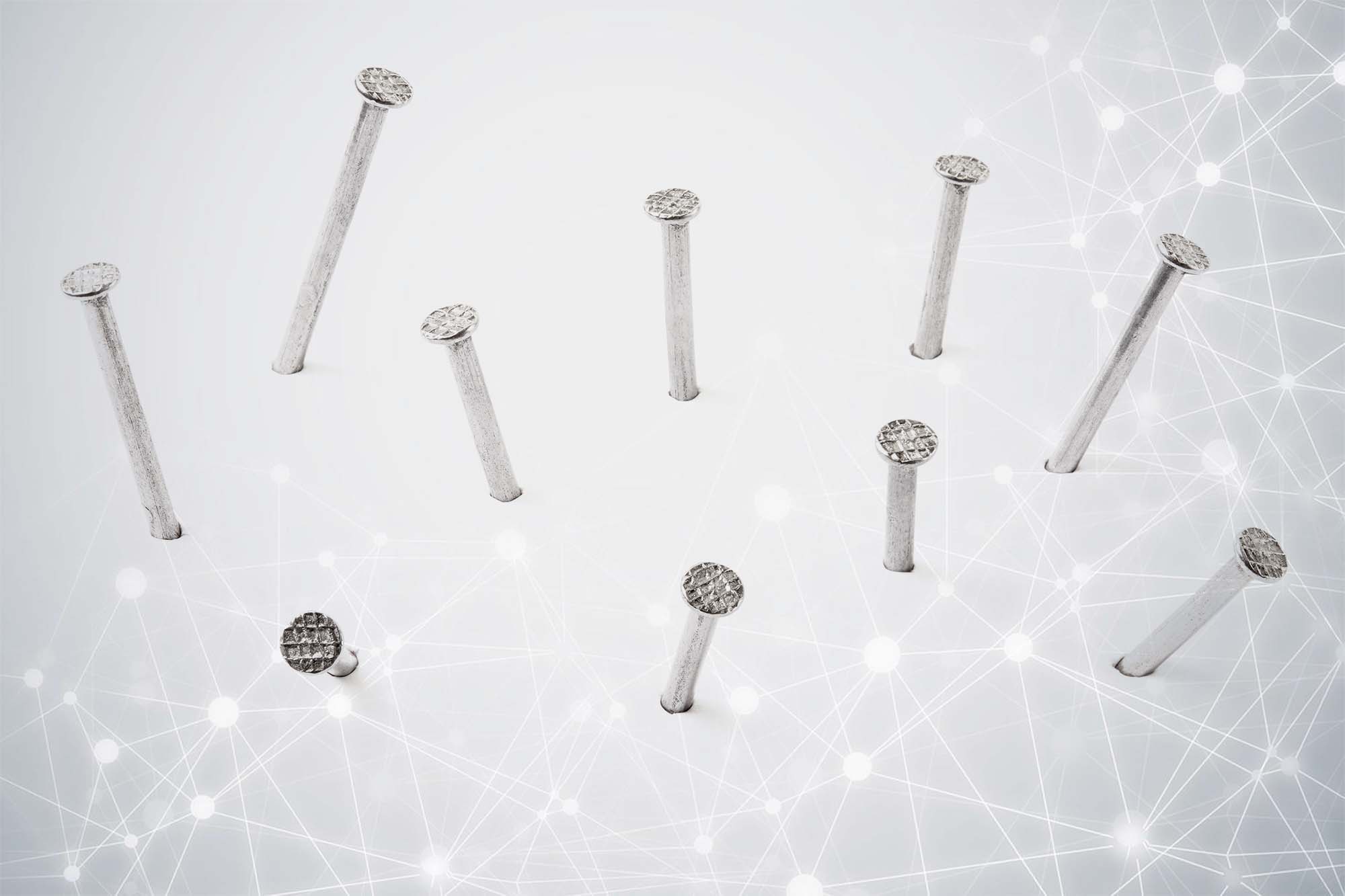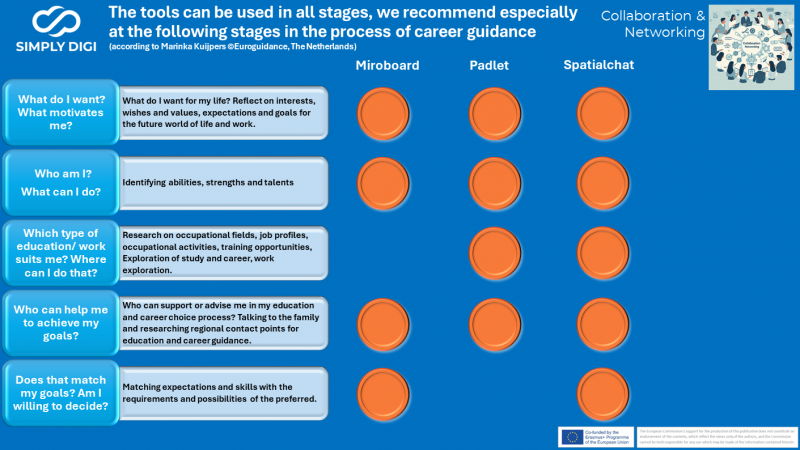
Networking and collaborating for the careers of our youth
Tools from this category promote collaboration and exchange between users. In career guidance, they are valuable for supporting communication and networking between students, teachers, career counselors and employers. They enable joint projects and discussions about career opportunities, educational paths and market trends.
Miro-Board
Overview:
The Miro Board is a digital whiteboard and comprehensive collaborative online tool that is particularly suitable for teamwork in tandems or small to medium-sized groups. It supports a wide range of activities, from creating strength profiles to brainstorming about specific professions.
Applications:
For career orientation, students can create strength profiles on the Miro Board that include both self-perception and external perception, or brainstorm about professions such as that of a mechatronics engineer. These activities promote understanding of one’s abilities and career possibilities.
Placement in the career orientation process:
The Miro Board supports various phases of career orientation: from self-reflection and identification of strengths to exploring professional fields and weighing training opportunities. It serves as a platform for engaging with career goals and preparing for decision-making.
Potential:
With its versatility and the possibility for real-time collaboration, the Miro Board offers great potential to make career orientation interactive and engaging. It allows for a visual and creative approach to exploring career paths, which can be implemented both individually and in group work.
Pricing: Free of charge for schools
Website: Link
Website located in (GDPR / DSGVO): Ireland (and USA)
GDPR/DSGVO compliant: ☒yes ☐no | Privacy information
Padlet
Overview:
Padlet functions like a digital pinboard, allowing for the collection and sharing of texts, images, photos, videos, links, and more at a central location. This tool offers an innovative platform for information dissemination and collection, ideal for career orientation.
Applications:
In schools, Padlet can be used for designing career orientation by enabling students to create strength profiles, reflect on professional interests, and collect information on various professional fields. Companies can use it to provide relevant information to interns and trainees.
Placement in the career orientation process:
Padlet supports several phases of career orientation, starting with self-reflection (“What do I want? What motivates me?”) through recognizing skills and talents to exploring training and work opportunities. It serves as a platform to exchange information on personal goals and the future world of work and to collect information.
Potential:
Due to its versatility and user-friendliness, Padlet has great potential to make career orientation interactive and appealing. It promotes active participation of learners and supports the collaborative development and discussion of content, deepening the exchange of information and understanding of career opportunities.
Pricing: Free version or from €199/year
Website: Link
Website located in (GDPR / DSGVO): USA
GDPR/DSGVO compliant: ☐yes ☒no | Privacy Information
SpatialChat
Overview:
SpatialChat is an innovative tool that mimics social interactions through video chat conversations in a virtual environment. It allows up to 50 participants to meet in a room to chat, share their screen, watch images and videos together, and much more.
Applications:
The tool offers flexible applications for career orientation by enabling meetings and conversations in an engaging, virtual space. It can be used for discussions, group work, lectures, and even for transnational “European” learning environments to interactively address topics of career orientation.
Placement in the career orientation process:
SpatialChat supports all phases of career orientation – from self-reflection on interests, desires, and values, recognition of abilities, strengths, and talents, to exploring professional fields, training opportunities, and seeking support in the decision-making process. It promotes exchange and discussion on professional perspectives and supports decision-making.
Potential:
With its unique ability to create virtual spaces for interactions, SpatialChat has great potential to enrich career orientation. It enables a new way of networking and exchange, particularly valuable in the current, increasingly digitalized educational landscape. The platform can help increase student engagement and participation and foster a deeper engagement with professional topics.
Pricing: Limited Free Version; otherwise from 499 € /year
Website: Link
Website located in (GDPR / DSGVO): Limassol, Cyprus
GDPR/DSGVO compliant: ☒yes ☐no | Privacy Information
-
“Vocational Orientation at School: Preparation for Education and Career”
-
“Extracurricular Career Orientation: Building Bridges for Young People”
-
“Pure practice: professional experience directly in the company”
-
“Personal Advice: Tailor-made Paths in Education and Career”
-
“Across Borders: European Perspectives in Career Guidance”
- Career Orientation at School: Preparation for Education and Career
In this classic learning environment, young people receive an initial overview of various occupational fields and career paths within the school. Teachers and career guidance teachers are the main ones responsible for preparing students for the world of work through targeted teaching units, projects and information events. Guest lectures by professionals and excursions to companies complement the program to ensure practical insights.
- Extracurricular career orientation: Building bridges for young people
This learning environment offers young people the opportunity to acquire more in-depth knowledge and skills in specialised courses or activities offered outside of school by educational organisations, associations or local employment agencies. There are special offers for young people with special challenges. Here, they are supported by experienced educational and career counsellors who respond individually to the interests and abilities of the young people and help them to find their professional direction and make decisions.
- Pure practice: professional experience directly in the company
In companies, young people are given the opportunity to gain direct professional experience through internships or training programmes. You will learn about specific work processes and requirements and will be able to get a realistic picture of everyday working life. Trainers and employees of the company are responsible for the support and guidance, who act as mentors to the young people and offer them valuable insights into professional practice.
- Personal advice: Tailor-made paths in education and work
In individual or small group-oriented counselling phases, educational and career counsellors offer personal support in various organisations such as counselling centres or employment agencies. This includes assistance in the preparation of application documents, preparation for job interviews and the development of individual career plans. The counsellors use their expertise to respond to the personal needs and situations of the young people and to support them in a targeted manner.
- Across Borders: European Perspectives in Career Guidance
Cross-border “European” learning environments give young people the opportunity to look beyond the national framework and explore international career opportunities. Through programmes such as Erasmus+ or other European exchange programmes, they are supported by coordinators and international career counsellors. These offer insights into the European labour market, promote the development of intercultural competences and support the planning of stays or internships abroad in order to improve career opportunities in an international environment.
When using digital tools for young people, you should pay special attention to the following aspects:
- Use moderated platforms: Make sure the platforms are moderated to encourage positive and respectful communication.
- Protect your privacy: Be careful with your data on collaboration and networking platforms.
- Create inclusive communities: Engage in creating an inclusive environment that welcomes all youth regardless of their background.
Tips and hints about video quality and camera settings
- Resolution: At least 1080p (Full HD) is recommended to ensure good image quality. For more professional content, or if bandwidth allows, 4K is an even better option.
- Camera position: The camera should be at eye level. Use books or an adjustable stand to orient the camera accordingly if necessary.
- Frame: The speaker should be positioned centrally, with the upper edge of the image just above the head and the bottom edge at about chest height. This conveys closeness without being too intrusive.
- Background blur: If your camera or software supports it, a slightly blurred background can increase the focus on the person in front of the camera and make for a more professional look.
Microphone Settings
- Microphone type: A condenser microphone is best for clear voice recordings. Lavalier microphones are a great choice for freedom of movement, while USB microphones offer a simple but high-quality option.
- Position: The microphone should be placed close to the mouth, ideally at a distance of 15-30 cm. Avoid speaking directly into the microphone to minimize plosive sounds (such as P’s and B’s).
- Background noise: Try to record in as quiet an environment as possible. Pop filters and windshields can help further reduce unwanted noise.
Distance to the screen and viewing direction
- Screen distance: Work at a comfortable distance from the screen. Arm spacing is often recommended to support an ergonomic posture.
- Viewing direction: Look directly into the camera to simulate eye contact with the viewer. This promotes connection with the audience and makes the presentation more personal.
Decoration and lighting
- Lighting: Natural light from the front is ideal. Avoid harsh shadows on the face by evenly distributing light. In the case of artificial lighting, you should use soft light that illuminates the face evenly.
- Decoration: The background shouldn’t be distracting, but it shouldn’t look too sterile either. Simple, tidy environments with a few, thoughtful decorative elements such as plants or bookshelves look professional and appealing.
- Color palette: Use calming, neutral tones for both the background and clothing to minimize distractions and keep focus on the content.
General Tips
- Test shots: Take test shots to check settings and surroundings before you start the actual recording.
- Continuous learning: Stay up-to-date on new technologies and methods to continuously improve your video quality.
Miro & Padlet: Tips
- Objective: Start with a clear goal for your Miro board or padlet to target the content and layout.
- Templates and layouts: Take advantage of Miro’s wide range of templates and Padlet’s different layout options to get started efficiently and purposefully.
- Encourage collaboration: Actively invite team members to collaborate and use real-time communication tools to streamline sharing and collaboration.
- Organization and structure: Keep your boards organized by using color codes, tags or categories and group similar elements visually.
- Integrations & Workflow: Incorporate Miro and Padlet into your existing workflow by leveraging integrations with other tools like Slack, Google Drive, or Jira.
- Security and access rights: Be aware of the access rights and privacy settings to securely share and protect your information.
- Feedback and moderation: Use the comment function to collect feedback and stimulate discussion. Review and moderate posts to ensure content relevance and quality.
- Export options: Consider Padlet’s export options for sharing and archiving project results outside of the platform.




